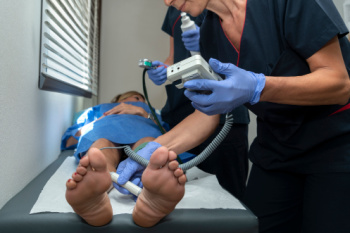
The Ankle-Brachial Index, or ABI, is a simple, non-invasive test that measures blood flow in the legs compared to the arms. In podiatry, it helps detect peripheral artery disease, or PAD, a condition where narrowed arteries reduce circulation to the feet and ankles. Poor circulation can lead to slow-healing wounds, infections, and an increased risk of ulcers or even limb loss. The test involves taking blood pressure readings at the arm and ankle using a Doppler device. A lower than normal ABI score suggests reduced blood flow, which could mean blocked or narrowed arteries. People with diabetes, a history of smoking, or chronic foot wounds often undergo this test to assess their vascular health. Early detection of circulation issues allows for better management, including lifestyle changes or medical treatment. If you have persistent foot pain, wounds that do not heal well, or cold feet, it is suggested that you see a podiatrist who may recommend an ABI test.
Vascular testing plays an important part in diagnosing disease like peripheral artery disease. If you have symptoms of peripheral artery disease, or diabetes, consult with Richard M. Allen, DPM from Idaho. our doctor will assess your condition and provide you with quality foot and ankle treatment.
What Is Vascular Testing?
Vascular testing checks for how well blood circulation is in the veins and arteries. This is most often done to determine and treat a patient for peripheral artery disease (PAD), stroke, and aneurysms. Podiatrists utilize vascular testing when a patient has symptoms of PAD or if they believe they might. If a patient has diabetes, a podiatrist may determine a vascular test to be prudent to check for poor blood circulation.
How Is it Conducted?
Most forms of vascular testing are non-invasive. Podiatrists will first conduct a visual inspection for any wounds, discoloration, and any abnormal signs prior to a vascular test.
The most common tests include:
- Ankle-Brachial Index (ABI) examination
- Doppler examination
- Pedal pulses
These tests are safe, painless, and easy to do. Once finished, the podiatrist can then provide a diagnosis and the best course for treatment.
If you have any questions, please feel free to contact our office located in Lewiston, ID . We offer the newest diagnostic and treatment technologies for all your foot care needs.
